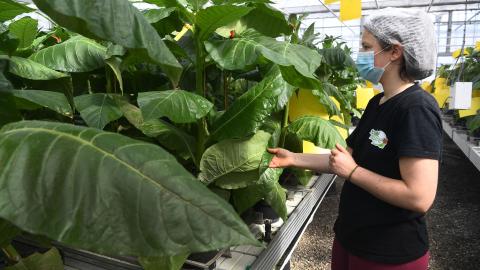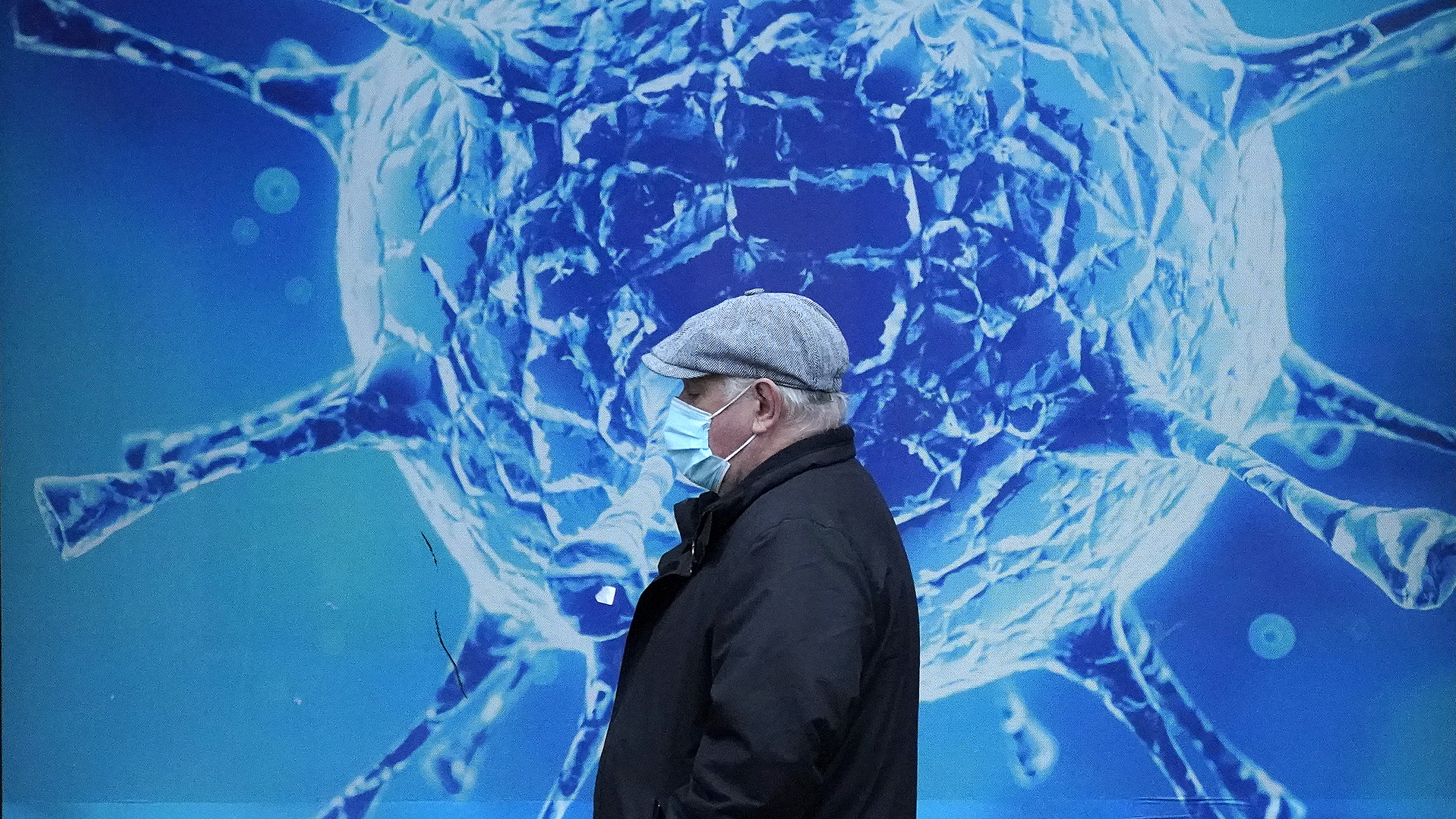Plant-based vaccines can change the vaccine landscape

Credit: FRED TANNEAU via Getty Images
- Vaccines are absolutely crucial to keeping the entire planet healthy. None of us is safe until all of us are safe.
- But low- and middle-income countries have a difficult time acquiring and distributing them.
- Plant-derived vaccines can be stored by harvesting and freeze-drying the leaves. They may help solve the problem of global vaccine distribution.
Vaccines are the mainstay of the efforts to quell the COVID-19 pandemic. The pace of their development and refinement has been astonishing, but the characteristics of many of the available vaccines will make getting them to poor countries challenging. We will need more heat-stable vaccines that can be easily transported and stored. One ongoing, promising approach to this is to produce them in plants.
Populations in many richer countries could return to a reasonable approximation of normal by the fourth quarter of this year if — a big if — they can vaccinate 80 percent or more of their populations against SARS-CoV-2. They will also need to perform constant surveillance for “variants of concern” that are more transmissible, cause more severe disease, or, especially, are better able to escape the immunity conferred by COVID-19 vaccines. An example is the coronavirus variant called “delta,” first detected in India, which has become the dominant strain in the United Kingdom, despite that country’s highly successful vaccination campaign. That variant now accounts for about 6 percent of infections in the United States, double its penetrance a month ago.
Vaccinating poorer countries is an enormous challenge
Prospects for poorer countries are very different, however, for every aspect of the pandemic — cases, hospitalization, deaths, and ability to suppress the pandemic with vaccines — which are, for many reasons, more elusive than for wealthier countries.
Some middle-income nations such as India and Brazil recently have experienced a devastating surge in cases after premature loosening of restrictions in their countries. Africa’s toll of cases and deaths is surprisingly low, although the paucity of data makes the government-reported numbers suspect.
The task of rapidly manufacturing vast quantities of COVID-19 vaccines that are safe, efficacious, inexpensive, and transportable without stringent cold chain requirements is daunting.
Especially in lower- and middle-income countries, vaccines will be a lifeline, but providing sufficient COVID-19 vaccines for their populations will take years at current trajectories. At India’s current vaccination rate of 1.8 million doses a day, for example, it would take more than three years to vaccinate 80 percent of its 1.4 billion people. Likewise, over 24 million people — less than two percent of the population — have been fully vaccinated in Africa (according to the Africa C.D.C.). Currently, a meager 0.3 percent of the vaccine doses that have been administered around the world have been provided to the 29 poorest countries. By contrast, in the United States, over 60 percent of adults have by now received at least one shot of vaccine.
Although the U.S. has purchased more than enough vaccines for its entire population, it may choose to hold onto some of its excess in case booster shots of existing vaccines are required this fall or early next year. It is also possible that the U.S. will be poised to divert domestic production to making new vaccines that will overcome “immune evasiveness” in subjects vaccinated with current vaccines.
This development could compromise the capacity to scale up manufacturing to provide global access to vaccines, further widening the gap between vaccine haves and have-nots, particularly in low resource settings where scaling access, distribution, refrigeration, and affordability are problematic. The Pfizer-BioNTech and Moderna mRNA vaccines, for example, which have cold chain limitations (an uninterrupted series of refrigerated production, storage, and distribution requirements), would be difficult to distribute in resource-poor settings such as rural India or Africa.
Advances have been made in the formulations of some vaccines so that the need for refrigeration can be avoided. Past successes include a freeze-dried version of the smallpox vaccine, which was critical for eradication of that deadly disease. Making a freeze-dried version of mRNA vaccines such as Pfizer and Moderna may be feasible but could be cost-prohibitive for a global market. The estimated costs of the global vaccination effort could reach $74 billion, according to a study published in The Lancet.
These challenges together could stymie our efforts to control the pandemic for years to come, bringing to mind the often-heard mantra: “None of us is safe until all of us are safe.” Our inability to manufacture large quantities of vaccines rapidly would extend the pandemic, resulting in stress on healthcare and national economies, and increased mortality, all the while enabling more SARS-CoV-2 variants to emerge and gain a foothold.
The task of rapidly manufacturing vast quantities of COVID-19 vaccines that are safe, efficacious, inexpensive, and transportable without stringent cold chain requirements is daunting. These challenges may be insuperable unless we try to replicate with plant-based COVID-19 vaccines the recent clinical successes with mRNA vaccines.
Plant-based vaccines are a potential solution

Plant-based vaccines are likely the promise of the future for mass vaccination in lower- and middle-income countries. For millennia, plants have not only been sources of food, fiber, and fuel, but also, more recently, an important component of our medicine cabinet as well. The identification and application of bioactive molecules from medicinal plants is nothing new; examples include the active ingredient of aspirin, salicylic acid, derived from willow and used as a painkiller; taxol from yew trees to treat cancer; digitalis from the foxglove plant; and the malaria drug artemisinin from sweet wormwood; among others.
But those examples are yesterday’s successes. Our newly-acquired ability to genetically engineer plants that express novel biologics, such as vaccines to combat pandemic flu or antibodies to block Ebola virus infection, shows how far we have come. These new pharmaceuticals are easily scalable, inexpensive to produce, and have no cold chain requirements. Plant-based vaccines to prevent COVID-19 are certainly within our grasp.
While much of the initial research concerning plant made vaccines has been conducted by stably expressing the protein of interest in genetically engineered plant tissue, plant viruses can also be harnessed to generate biopharmaceutical proteins rapidly (within a matter of days) and at low cost. Plant viruses can also act as scaffolds, displaying vaccine epitopes on the surface of self-assembled virus-like particles (VLPs). These VLPs lack nucleic acid and are, therefore, non-infectious and harmless to animals or plants.
Plant-derived vaccines can be stored by harvesting and freeze-drying the leaves, or merely by isolating the plant virus, if one was used as the antigen carrier. Moreover, a number of plant viruses have been shown to behave as adjuvants and help to stimulate a stronger immune response overall. This technology is currently being employed by several plant “molecular pharming” companies to produce vaccines for COVID-19 that would be suitable for India, Africa, and other places in need.
Plant-based COVID vaccines
Quebec plant molecular pharming company Medicago announced in a press release last month the successful completion of a phase 2 clinical trial of their plant-derived COVID-19 vaccine candidate, which contains an adjuvant obtained from GlaxoSmithKline (GSK). The titer of neutralizing antibody and the degree of cell mediated immunity the vaccine elicited were robust, and no severe adverse effects were reported.
The vaccine is based on the virus-like particle technology mentioned above. These VLPs assemble in plants with the spike protein displayed on their surface, so that the end product looks just like the real thing but is non-infectious. Medicago is currently moving their vaccine through a stage 3 clinical trial and has “fast track” designation from the FDA. The company estimates that they will be able to produce up to 80 million annual doses beginning this year, and by 2023, over a billion doses of COVID-19 vaccine doses per year. That could be just what low- and middle-income countries will need to suppress the COVID-19 pandemic.
Other plant molecular pharming companies are not far behind. Kentucky BioProcessing (KBP), a member of British American Tobacco group, uses a technology similar to Medicago’s to produce COVID-19 vaccines in plants. KBP’s previous claim to fame was producing antibodies in plants to block Ebola infection, and KBP’s plant-based COVID-19 vaccine has successfully elicited an immune response to the virus in animals and is currently moving into clinical trials. The company also uses a virus-based technology. Attaching the vaccine antigen to the plant virus provides the vaccine with greater stability at room temperature. This plant virus is also non-infectious to humans but can be taken up by immune cells to elicit a strong response.
A third company that is making headway is Texas-based iBio, which is working on several vaccine candidates. These include a virus-like particle, a subunit vaccine, and a second-generation vaccine that targets the SARS-CoV-2 virus’s N protein, which is more conserved than the spike protein. The N protein is, therefore, less likely to mutate, even when virus variants emerge and circulate, thus making the vaccine more likely to be successful against variants. These vaccines have performed well in pre-clinical and toxicology studies.
As microbes mutate, we must innovate
The current pandemic is far from over, and scaled up vaccination programs are needed immediately to reduce the spread of COVID and decrease the emergence of new variants of concern. While vaccine distribution certainly remains a significant obstacle for many countries, simply ramping up vaccine manufacturing is currently our greatest challenge. At least some of this burden could be alleviated by adding plant-made vaccines to our global arsenal. They are safe, inexpensive, efficacious, easy to produce in large amounts, and are less susceptible to cold chain requirements for distribution and administration. The rapid scale-up of COVID-19 plant-made vaccines could be a significant step toward suppressing or even ending the pandemic, as well as offering an important new technology for the future.
Kathleen Hefferon, Ph.D., teaches microbiology at Cornell University. Find Kathleen on Twitter @KHefferon. Henry Miller, a physician and molecular biologist, is a senior fellow at the Pacific Research Institute. He was a Research Associate at the NIH and the founding director of the U.S. FDA’s Office of Biotechnology. Find Henry on Twitter @henryimiller.





